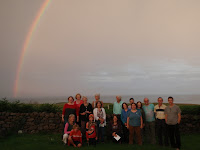Tuesday 10 September 2013
the Mycelium Choir
I’ve just returned from running a singing course in Bild-Werk Frauenau- on the German/Czech border, my 6th since 2001. It is a Centre for the Arts with a unique and wonderful atmosphere, where people from all over the world come to learn and experiment with different artistic mediums, with a particular expertise in glass techniques. Frauenau, a small town surrounded by the Bavarian forest and mountains, has for centuries been an area for glass production, similarly across the border in the Czech Republic. These days, what with cheap imports from Asia, hand blown glass manufacture is struggling, but Bild-Werk continues to offer creative courses in flat glass, glass engraving and blowing and other techniques, as well as in many other arts and crafts.
My bi-annual singing course is now affectionately known as “die Candy singers”. 24 of us, ranging from complete beginners, to highly experienced singers, spent a wonderful week learning and exploring songs: Czech, gospel, even attempting a short song by Brahms.
We had some interesting ongoing conversations between us about what actually goes on when we sing together, and how much it makes us feel happy and fulfilled. We came to the conclusion that modern life, with its emphasis on doing your own thing, being an individual, leaves many people with a deep down loneliness, an indefinable sense of not ‘Belonging’. But when we sing together, we feel complete, and a wonderful sense of wellbeing, of coming home.
I am fascinated how singing builds contact, friendship, tolerance between people. We see each other as individuals, with our differing vulnerabilities and strengths, but we also develop a common bond through singing together. Somehow our differences mean less, our common humanity gains prominence. I believe we are working with forces that we don’t fully understand, that we feel and sense but scientists have just not discovered yet. When we sing together, we create an invisible vessel- a zone- between us, that you then automatically tap into, next time you sing with those same people.
I have learnt through my interest in plants and food, about Mycelium- small white fungal threads that grow under the soil, connecting plants and trees to create a whole ecosystem. They support, indeed promote the health of the whole forest. The forest is weaker, more disease prone without them.
I believe singing is the invisible Mycelium for human well-being.
This is a Mycelium choir!
Sing on the isle of Eigg
Our singing holiday on the isle of Eigg launched an epic trip around Scotland and Ireland for Robin and me in a reckless camper van. Eigg lies off the coast of Scotland, an hour’s ferry trip from Mallaig. 85 people live there full time, and they claimed well earned fame 17 years ago by successfully buying out their own island from an absentee Dutch landlord.
We met many islanders, including Donna the Piper, sharing stories, songs and hearing about the history. Our first trip was to Laig Bay, a glorious strip of white sandy beach, shrouded in a white lighted mist when we arrived. As we lay, soaking up the warmth of the misty sun, 2 cows nonchalantly strolled past us to the sea’s edge, and spent their whole day paddling, walking up and down the length of the beach. A while later, Michael called out Look! In front of us rose 2 enormous mountains: they appeared as if 500 yards away, but it was the island of Rhum, actually 5 miles away. We were in faery land. Gradually as the mist cleared, the whole panorama revealed itself.
One of the aims of my singing holidays is to sing songs that originate from the place we stay in, connecting us more deeply to the people, landscape, the ancestral energy of the place. In preparation, I had researched a song collected 100 years ago from the northern township of Cleadale on Eigg, sung “to the slow rhythmic swing of the stacking of the hay”. Its melancholy feel didn’t seem to fit its use, make much sense, but as we learnt it, along with a singer who lived in Cleadale, we realized the characteristic upwards octave jump of the melody reflected the movement of the tossing up of the hay onto a high haystack. You needed the slow tempo to bend down, collect the next pitchfork of hay, before tossing up again. I love this - the line of the song was created through the action of the work. Only through the process of doing the action as we sung did we discover this.












Subscribe to:
Posts (Atom)





